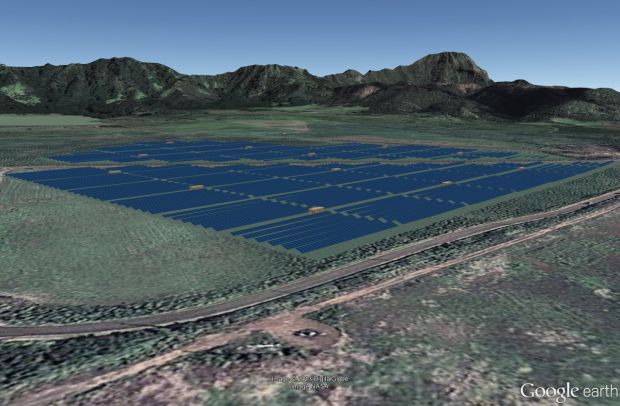LIHUE — Kauai Island Utility Cooperative officials are moving forward with a plan to build the state’s largest photovoltaic facility in Koloa after state regulators issued their seal of approval on Wednesday. Plans for the $41.2 million project, which were
LIHUE — Kauai Island Utility Cooperative officials are moving forward with a plan to build the state’s largest photovoltaic facility in Koloa after state regulators issued their seal of approval on Wednesday.
Plans for the $41.2 million project, which were approved by the state’s Public Utilities Commission earlier this week, calls for the build out of a 12-megawatt plant on 67 acres of leased land owned by Grove Farm Company affiliate Haupu Land Company LLC.
KIUC Communications Manager Jim Kelly said plans for the large-scale Koloa facility dates back to early last year, when the cooperative began soliciting project proposals from large landowners throughout the island.
Cooperative officials selected the Grove Farm property and Mililani-based developer SolarCity to spearhead the project because of the site’s close proximity to KIUC’s Koloa substation, he said.
“We’re really making good, fast progress,” Kelly said. “We’re very happy with how quickly this project came together.”
The facility, according to approved PUC documents, was funded solely through a 25-year construction loan through National Cooperative Services Corporation, a Dulles, Va.-based cooperative financial servicer.
Kauai Renewable Solutions Two, LLC, a company wholly owned by KIUC, will be charged with constructing and operating the facility.
This arrangement, which would terminate after seven years and revert all obligations back to KIUC, was done to create tax incentives for project investors, Kelly said.
In all, cooperative officials estimate that the expected net cost of energy over the 25-year life of the facility will be $145 per megawatt-hour, but could fall even lower based upon tax benefits and loan interest rates.
Even with higher interest rates, the state’s Division of Consumer Advocacy found that “KIUC’s payment under this arrangement will be significantly less than what KIUC would pay under the pricing terms resulting from other purchase agreements,” according to PUC documents.
Once the facility is placed into service, KIUC officials estimate that cooperative members and customers will achieve about $275,000 per month in savings.
The new plant, Kelly said, would also displace 1.7 million gallons of oil, 35,000 tons of carbon emissions and meet about 5 percent of the island’s total energy consumption needs annually.
“It’s not only great for customers in terms of getting us off of imported oil, but will also contribute to reduced greenhouse gas emissions that we produce on Kauai,” Kelly said.
The commission’s approval also includes a curtailment clause, which stipulates that the cooperative will not be allowed to dump solar energy generated from the Koloa plant for more than 90 hours per calendar year.
This clause, Kelly said, addresses concerns raised earlier this year by commission officials against Maui Electric Company, a Hawaiian Electric Company-subsidiary, for curtailing energy from its wind plants for those generated by oil plants.
“We’re not building these projects to curtail solar energy,” Kelly said. “Our forecast is that we’ll be able to put all of this energy to use, so we’re hoping that curtailment is something that we won’t have to consider at all for any of our projects.”
Construction is tentatively scheduled to begin in the third quarter of this year once the cooperative receives all of the necessary construction equipment and county permits.
• Darin Moriki, staff writer and photographer, can be reached at 245-0428 or dmoriki@thegardenisland.com.


